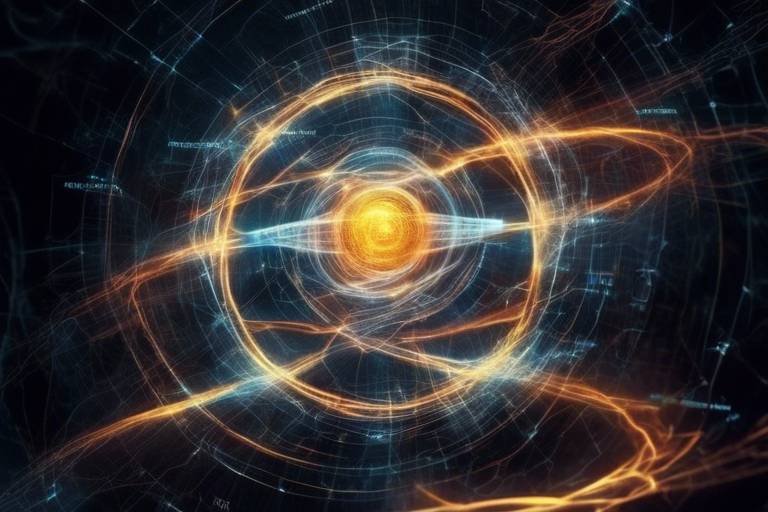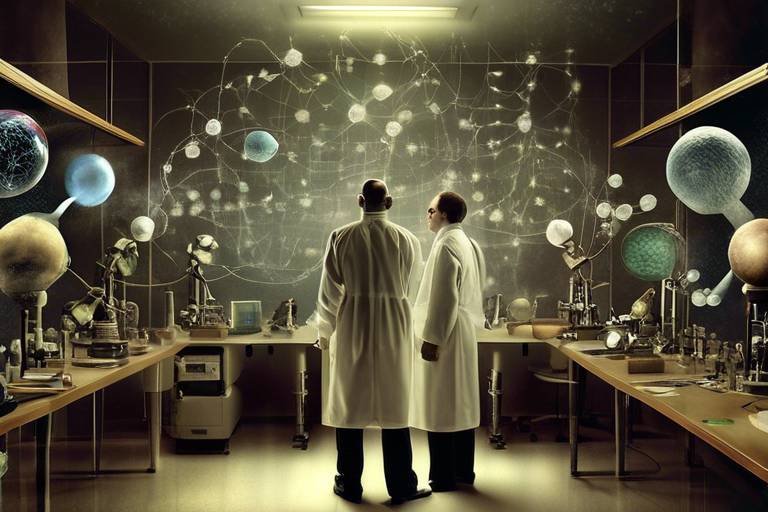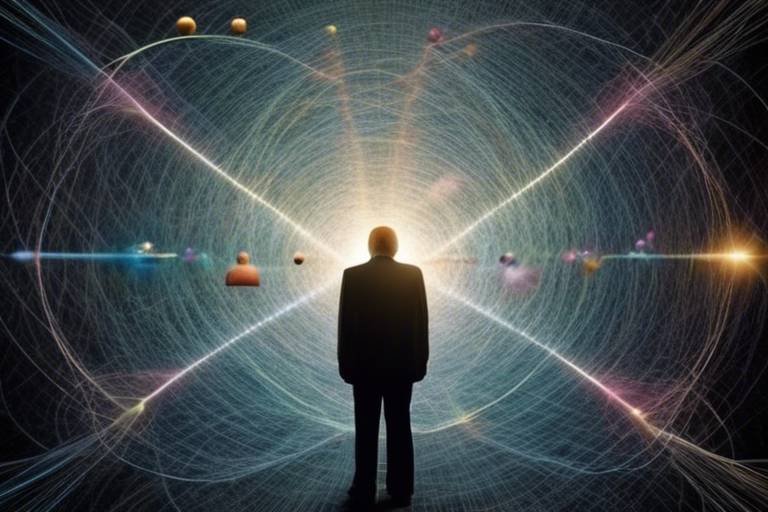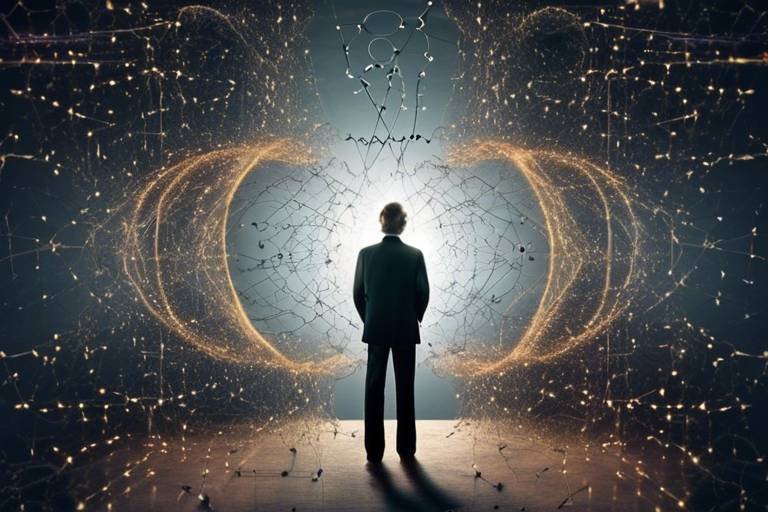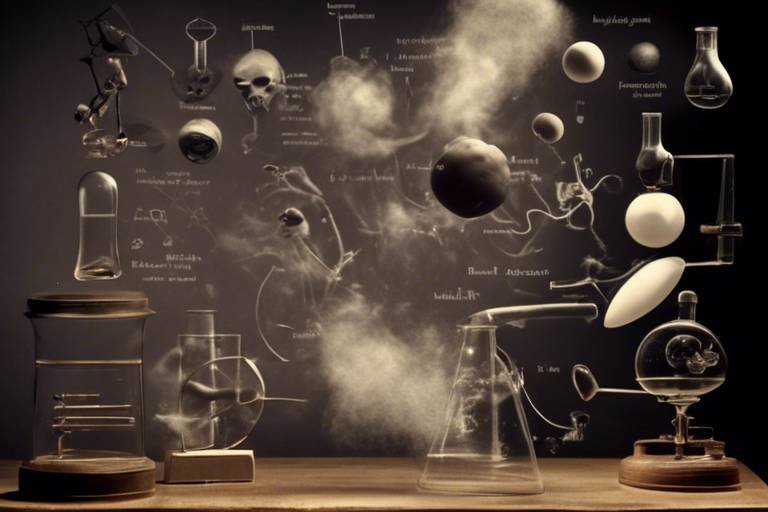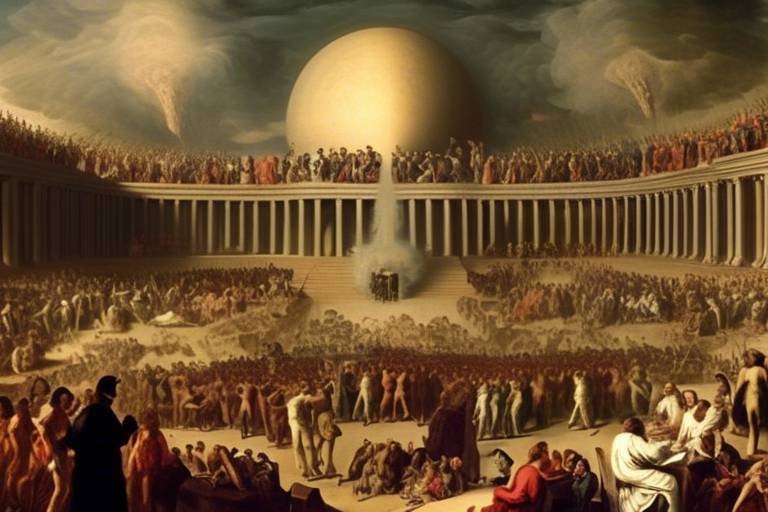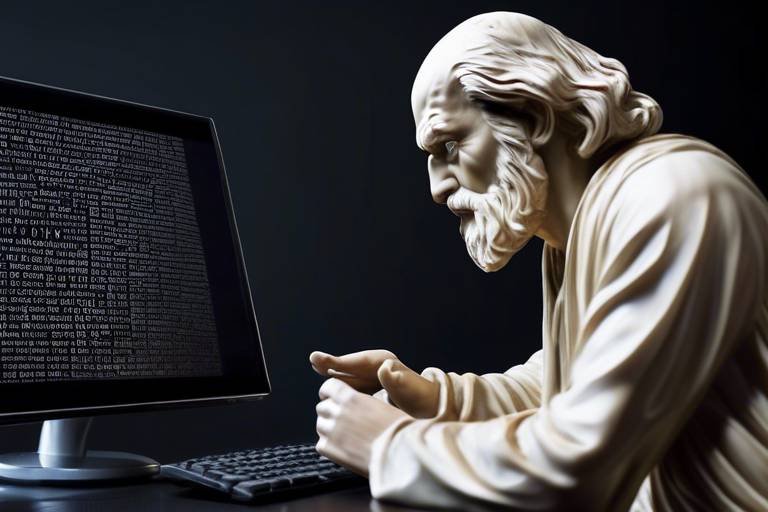Confronting Creationism – A Philosophical and Scientific Standpoint
In a world where science and faith often collide, the debate surrounding creationism versus evolution remains a hotbed of discussion. This article aims to unravel the intricate tapestry of philosophical and scientific arguments against creationism, shedding light on its implications for education, society, and our understanding of evolution. By delving into various perspectives and the robust evidence supporting a scientific worldview, we hope to foster a deeper understanding of this critical issue.
To grasp the full impact of creationism on contemporary thought, it's essential to explore its historical roots. Creationism, in its various forms, has existed for centuries, often intertwined with religious beliefs that provide explanations for the origins of life. Its acceptance in different cultures has been shaped by historical events, such as the rise of the scientific method during the Renaissance and the subsequent Enlightenment period, which challenged traditional views of the universe and humanity's place within it. The clash between scientific discoveries and literal interpretations of religious texts has led to significant cultural shifts, raising questions about the nature of belief and the validity of empirical evidence.
When it comes to the debate over creationism, the scientific community presents a wealth of evidence that supports the theory of evolution. This evidence is not merely anecdotal; it is grounded in rigorous research and observation. From the fossil record to genetic studies, the data consistently challenge creationist claims. These scientific findings provide a framework for understanding the complex processes that have shaped life on Earth over millions of years.
The fossil record stands as a monumental testament to the reality of evolution. It documents the gradual changes in species over time, showcasing transitional forms that illustrate the evolutionary process. For instance, fossils of early amphibians provide a glimpse into the transition from water to land, while the discovery of feathered dinosaurs offers insight into the evolution of birds. Each fossil serves as a chapter in the story of life, revealing the intricate connections between past and present organisms.
In addition to fossil evidence, molecular biology has opened new avenues for understanding evolutionary relationships. By comparing DNA sequences among various species, scientists have uncovered striking genetic similarities that point to a shared ancestry. This molecular evidence not only supports the theory of evolution but also challenges the creationist narrative that posits distinct, unchanging kinds. The more we study genetics, the clearer the picture of our interconnectedness becomes, highlighting the beauty and complexity of life.
Central to the theory of evolution are the mechanisms of natural selection and genetic drift. Natural selection, often summarized by the phrase "survival of the fittest," explains how advantageous traits become more common in a population over generations. Genetic drift, on the other hand, describes the random changes in allele frequencies that can lead to significant evolutionary changes over time. Together, these processes illustrate the dynamic nature of species and their ability to adapt to changing environments, further undermining creationist claims of static life forms.
Education plays a pivotal role in shaping public understanding of science and evolution. However, educators face numerous challenges when teaching evolution, particularly in regions where creationist beliefs are prevalent. This tension can lead to the dilution of scientific curricula, as some schools attempt to accommodate creationist views by presenting them alongside established scientific theories. This not only confuses students but also undermines the integrity of science education, leaving future generations ill-equipped to engage critically with scientific concepts.
Beyond the scientific discourse, the philosophical implications of creationism provoke deeper questions about knowledge, belief, and the nature of reality. At its core, creationism challenges our understanding of epistemology—the study of knowledge and justified belief. How do we know what we know? Creationist beliefs often stem from faith-based perspectives that prioritize religious texts over empirical evidence, raising significant epistemological challenges. The clash between faith and reason invites us to reflect on the sources and limits of our knowledge.
The epistemological questions surrounding creationism compel us to examine how different worldviews shape our understanding of truth. For many, faith provides a foundation for knowledge, yet this can conflict with scientific reasoning, which relies on observation, experimentation, and evidence. This dichotomy raises critical issues about the validity of different types of knowledge and the criteria we use to determine what is true.
Moreover, the metaphysical implications of creationism invite us to reconsider our perceptions of existence and the universe. Creationist beliefs often posit a purposeful design behind life, contrasting sharply with scientific explanations that emphasize randomness and natural processes. This divergence sparks profound questions about the nature of reality and humanity's place within it, challenging us to reconcile faith with scientific understanding.
The influence of creationism extends beyond the realms of science and philosophy into the fabric of society itself. Creationist beliefs shape cultural attitudes toward science, education, and public policy, often leading to polarization within communities. This cultural divide can hinder scientific progress and foster an environment where misinformation thrives. As society grapples with these issues, it becomes increasingly important to foster dialogue that bridges the gap between differing worldviews, promoting a more informed and scientifically literate populace.
- What is creationism? Creationism is the belief that life, the Earth, and the universe were created by a divine being, often as described in religious texts.
- How does evolution differ from creationism? Evolution is a scientific theory that explains the diversity of life through natural processes, while creationism relies on religious beliefs about divine creation.
- Why is the fossil record important? The fossil record provides evidence of transitional forms and the gradual changes in species over time, supporting the theory of evolution.
- What role does education play in this debate? Education is crucial for promoting scientific literacy and understanding of evolution, but it can be challenged by the presence of creationist beliefs in some communities.

The Historical Context of Creationism
To truly understand the phenomenon of creationism, we must first delve into its historical roots. Creationism, in its various forms, has been a part of human thought for centuries, often intertwined with religious beliefs and cultural narratives. The origins of creationist thought can be traced back to ancient civilizations, where myths and stories about the creation of the world were prevalent. For instance, many ancient cultures, such as the Mesopotamians and Egyptians, had their own creation myths that explained the origins of life and the universe.
As the centuries progressed, the rise of monotheistic religions, particularly Judaism, Christianity, and Islam, solidified creationist views. These religions presented a unified narrative about the creation of the world, often rooted in sacred texts. The Biblical account of creation, particularly in the book of Genesis, became a cornerstone for Christian creationism. This narrative posits that God created the world in six days, a belief that has influenced countless adherents throughout history.
However, it wasn't until the Enlightenment and the Scientific Revolution that the seeds of conflict between science and creationism began to sprout. With the advent of scientific inquiry and the emphasis on empirical evidence, thinkers like Galileo and Newton laid the groundwork for a more scientific understanding of the universe. Yet, this shift also sparked a backlash from religious communities who felt threatened by these new ideas. The publication of Charles Darwin's On the Origin of Species in 1859 marked a pivotal moment in this ongoing struggle.
Darwin's theory of evolution by natural selection challenged the traditional creationist narrative, suggesting that species evolved over millions of years rather than being created in their current forms. This revolutionary idea was met with fierce resistance from creationists, who argued that it undermined the authority of religious texts. The infamous Scopes Monkey Trial in 1925 epitomized this conflict, as a teacher was tried for teaching evolution in a public school, highlighting the deep cultural divide between scientific and religious perspectives.
Throughout the 20th century, creationism continued to evolve, adapting to societal changes and scientific advancements. The rise of the Intelligent Design movement in the late 20th century sought to reframe creationist arguments by suggesting that life is too complex to have arisen through natural processes alone. This movement attempted to present a scientifically palatable version of creationism, although it was met with skepticism and criticism from the scientific community.
Today, creationism still holds significant sway, particularly in certain regions and among specific demographics. The ongoing debate over teaching evolution in schools remains a contentious issue, reflecting broader cultural tensions between science and religion. Understanding the historical context of creationism is crucial, as it informs not only the current debates but also the societal attitudes toward science and education.
| Period | Key Events |
|---|---|
| Ancient Civilizations | Development of creation myths (e.g., Mesopotamian, Egyptian) |
| Middle Ages | Rise of monotheistic religions; Biblical creation narrative |
| Enlightenment | Scientific inquiry begins to challenge religious views |
| 19th Century | Publication of Darwin's On the Origin of Species |
| 20th Century | Scopes Trial; rise of Intelligent Design movement |

Scientific Evidence Against Creationism
When it comes to the debate between creationism and evolution, the scientific community has amassed a wealth of evidence that strongly supports the theory of evolution while challenging the claims made by creationists. One of the most compelling aspects of this evidence lies in the fossil record, which provides a chronological account of life on Earth. Fossils serve as snapshots of past life forms, revealing a gradual change over time. For instance, the discovery of transitional fossils, such as Archaeopteryx, which exhibits both avian and reptilian features, demonstrates the evolutionary link between birds and dinosaurs. These fossils are not isolated incidents; they are part of a larger narrative that illustrates how life has evolved over millions of years.
In addition to the fossil record, molecular biology offers significant insights into the common ancestry of species. By comparing the DNA sequences of different organisms, scientists can trace evolutionary relationships and identify genetic similarities that challenge the notion of separate creations. For example, humans share approximately 98% of their DNA with chimpanzees, suggesting a recent common ancestor. This molecular evidence is further supported by the study of proteins and other biological molecules, which consistently reveal patterns of relatedness among diverse life forms.
Another fundamental aspect of evolutionary theory is the mechanism of natural selection. This process, first articulated by Charles Darwin, explains how advantageous traits become more common in a population over generations. Natural selection operates on the principle that individuals with traits better suited to their environment are more likely to survive and reproduce. This concept is not merely theoretical; it has been observed in numerous studies, including the famous example of the peppered moth during the Industrial Revolution, where darker moths had a survival advantage in polluted environments. Such real-world observations underscore the power of natural selection in shaping biodiversity.
Alongside natural selection, genetic drift plays a crucial role in evolution, particularly in small populations. This mechanism refers to random changes in allele frequencies that can lead to significant evolutionary changes over time. For instance, a natural disaster could wipe out a large portion of a population, resulting in a genetic bottleneck. The surviving individuals may not represent the original gene pool, leading to a shift in genetic diversity. This phenomenon illustrates that evolution is not solely a matter of survival of the fittest; randomness also influences the evolutionary process.
| Type of Evidence | Description | Example |
|---|---|---|
| Fossil Record | Chronological evidence of transitional forms | Archaeopteryx |
| Molecular Evidence | Genetic similarities among species | Humans and chimpanzees share 98% DNA |
| Natural Selection | Mechanism by which advantageous traits are selected | Peppered moth coloration changes |
| Genetic Drift | Random changes in allele frequencies | Population bottlenecks after disasters |
In conclusion, the scientific evidence against creationism is robust and multifaceted, encompassing fossil records, molecular biology, and evolutionary mechanisms such as natural selection and genetic drift. Each piece of evidence builds upon the last, creating a comprehensive understanding of how life on Earth has evolved over time. This understanding not only enriches our knowledge of biology but also challenges the creationist perspective, prompting us to reconsider our views on the origins of life.
- What is the main argument against creationism?
The primary argument against creationism is the overwhelming scientific evidence supporting evolution, including fossil records and genetic studies. - How does natural selection work?
Natural selection is the process by which organisms better adapted to their environment tend to survive and produce more offspring. - What role do fossils play in understanding evolution?
Fossils provide crucial evidence of transitional forms and help illustrate the timeline of life on Earth. - Can creationism and evolution coexist?
Many believe that creationism and evolution represent fundamentally different worldviews, making coexistence challenging in scientific discourse.

The Fossil Record
The fossil record is often described as the storybook of life on Earth, and for good reason. It provides a chronological account of the various organisms that have existed over millions of years, showcasing their evolution and the changes in biodiversity through time. Think of it as a time capsule that reveals not just the existence of ancient species, but also their anatomical structures, behaviors, and the environments they inhabited. This record is crucial for understanding the process of evolution, as it offers tangible evidence that supports the theory of natural selection.
One of the most compelling aspects of the fossil record is the discovery of transitional fossils, which serve as crucial links between different groups of organisms. For instance, the famous Archaeopteryx is often cited as a prime example of a transitional form between dinosaurs and birds. This feathered creature possessed both reptilian features, such as teeth and a long tail, and avian characteristics, including wings. Such fossils challenge the notion of distinct and unchanging kinds, which is a cornerstone of creationist belief.
Moreover, the fossil record is not just about isolated finds; it encompasses a vast array of discoveries that collectively paint a picture of life's history. For example, the following table summarizes some key transitional fossils and their significance:
| Transitional Fossil | Significance |
|---|---|
| Archaeopteryx | Link between dinosaurs and birds, showcasing feather evolution. |
| Australopithecus afarensis (e.g., Lucy) | Early hominin demonstrating bipedalism and ape-like features. |
| Tiktaalik | Transitional form between fish and tetrapods, illustrating the move to land. |
These findings are not just isolated events; they are part of a broader pattern that illustrates how life adapts and evolves over time. The fossil record also allows scientists to construct a timeline of life, revealing how species have emerged, evolved, and sometimes gone extinct due to environmental changes or competition. This timeline is essential for understanding the processes that drive evolution and the interconnectedness of all living things.
Furthermore, the fossil record provides insights into the extinction events that have shaped the course of evolution. Major extinction events, such as the one that wiped out the dinosaurs 66 million years ago, led to the rise of mammals and ultimately to the evolution of humans. By studying these patterns, scientists can better understand the resilience of life and the factors that contribute to biodiversity.
In conclusion, the fossil record stands as a formidable testament to the history of life on Earth. It not only supports the theory of evolution but also challenges creationist perspectives that deny the gradual changes observed in the natural world. As we continue to uncover new fossils and refine our understanding of life's history, we are reminded of the profound interconnectedness of all living organisms and the intricate tapestry of evolution that has shaped our planet.
- What is the significance of transitional fossils? Transitional fossils provide crucial evidence for the evolutionary links between different species, illustrating how one group can evolve into another over time.
- How do extinction events influence evolution? Extinction events can drastically alter ecosystems, allowing new species to emerge and thrive in the absence of dominant competitors.
- Why is the fossil record important for understanding evolution? The fossil record offers concrete evidence of the changes in life forms over millions of years, supporting the theory of evolution and challenging creationist views.

The study of molecular biology has revolutionized our understanding of the relationships among different species, providing a robust framework that supports the theory of evolution. At the heart of this evidence lies the concept of common ancestry. Essentially, all living organisms share a genetic blueprint, and this shared DNA serves as a powerful indicator of how life has diversified over millions of years. For instance, when we compare the DNA sequences of humans and chimpanzees, we find that approximately 98% of our genetic material is identical. This striking similarity suggests that we share a relatively recent common ancestor, challenging the creationist view that species were independently created and remain unchanged.
To further illustrate the significance of molecular evidence, consider the following points:
- Genetic Similarities: The analysis of genetic sequences reveals patterns that align with evolutionary theory. For example, the presence of similar genes across various species indicates a shared lineage.
- Mutations and Adaptations: Over time, mutations in DNA can lead to adaptations that enhance survival. These changes are not random; they follow a natural progression that can be traced through molecular evidence.
- Protein Comparisons: The structure and function of proteins across different organisms show remarkable similarities. By studying these proteins, scientists can infer evolutionary relationships that support the idea of a common ancestor.
Moreover, molecular evidence extends beyond mere comparisons of DNA sequences. The field of comparative genomics employs advanced techniques to analyze entire genomes, allowing scientists to construct phylogenetic trees that depict the evolutionary pathways of various species. These trees visually represent how closely related different organisms are, further solidifying the argument against creationist claims. For instance, the genetic divergence between species can be quantified, providing a timeline that aligns with the fossil record, thus reinforcing the narrative of evolution.
As we delve deeper into the molecular world, we also encounter the fascinating concept of horizontal gene transfer, particularly in microorganisms. This process allows genes to be transferred between species in ways that defy traditional evolutionary models. It highlights the complexity and dynamism of genetic evolution, showcasing how life adapts and evolves in response to environmental pressures. Such findings pose significant challenges to creationist interpretations that rely on a static view of species.
In summary, the molecular evidence not only supports the theory of evolution but also enriches our understanding of the interconnectedness of life. It challenges the simplistic narratives presented by creationism, urging us to embrace a more nuanced view of biological diversity. As science continues to advance, the molecular realm will undoubtedly unveil even more discoveries that deepen our appreciation for the intricate tapestry of life on Earth.
- What is molecular evidence? Molecular evidence refers to the data derived from the study of DNA, RNA, and proteins that supports the theory of evolution and common ancestry among species.
- How does DNA comparison support evolution? By comparing DNA sequences of different species, scientists can identify genetic similarities and differences that indicate a shared lineage and evolutionary history.
- What role do mutations play in evolution? Mutations introduce genetic variations that can lead to adaptations, which are essential for the process of natural selection and the evolution of species over time.

When we dive into the fascinating world of evolution, it becomes clear that two fundamental mechanisms stand out: natural selection and genetic drift. These processes are like the invisible hands guiding the development of life on Earth, shaping species over millions of years. But what do these terms really mean, and how do they work in the grand tapestry of evolution?
To start with, natural selection can be likened to a rigorous filter. Imagine a vast ocean filled with a variety of fish, each adapted to their specific part of the habitat. Some fish are faster, some are better camouflaged, and others are more resilient to changes in temperature. In this scenario, the fish that can best survive and reproduce in their environment are the ones that pass on their genes. Over generations, this leads to a population that is finely tuned to its ecological niche. This idea was famously summarized by Charles Darwin in his theory of evolution, where he stated that “the survival of the fittest” is not just about strength but about the best adaptations to a changing world.
On the other hand, genetic drift introduces a different flavor to the evolutionary process. Picture a small island with a limited number of birds. If a storm strikes and randomly wipes out a few of these birds, the remaining population’s genetic makeup may not reflect the original diversity. This random event can lead to significant changes in the population's traits over time, independent of natural selection. Genetic drift highlights how chance events can play a critical role in shaping the genetic landscape of populations, especially in smaller groups where the effects can be magnified.
Both mechanisms work hand in hand, influencing the course of evolution in profound ways. While natural selection is often the star of the show, driving adaptations and innovations, genetic drift can create unexpected shifts in a population's genetic diversity. In larger populations, the effects of genetic drift are often muted, but in smaller, isolated groups, it can lead to unique evolutionary paths.
To illustrate the differences and interactions between these mechanisms, consider the following table:
| Mechanism | Description | Impact on Evolution |
|---|---|---|
| Natural Selection | Process where organisms better adapted to their environment tend to survive and produce more offspring. | Leads to adaptation and speciation over time. |
| Genetic Drift | Random changes in allele frequencies in a population, often having a more significant effect in small populations. | Can lead to loss of genetic variation and fixation of alleles. |
In conclusion, understanding evolutionary mechanisms like natural selection and genetic drift provides us with a clearer picture of how life evolves and adapts over time. These processes remind us that evolution is not a straightforward path but rather a complex, dynamic interplay of various factors. It's this complexity that makes the study of evolution so endlessly intriguing and essential for grasping the biological diversity we see today.
- What is natural selection? Natural selection is the process whereby organisms better adapted to their environment tend to survive and produce more offspring.
- How does genetic drift differ from natural selection? Genetic drift is a random process that can lead to changes in allele frequencies in a population, while natural selection is a non-random process that results in adaptations.
- Can both mechanisms occur simultaneously? Yes, natural selection and genetic drift can and often do occur at the same time, influencing the evolution of species in different ways.

Education is not just about imparting knowledge; it's a powerful tool that shapes our understanding of the world. When it comes to the contentious debate between creationism and evolution, the role of education becomes even more critical. Imagine a world where students are equipped with the ability to think critically, analyze evidence, and make informed decisions. This is the essence of what a robust science education should provide. However, the reality is often more complex. Many educators face significant challenges when it comes to teaching evolution, particularly in areas where creationist beliefs are prevalent.
One of the primary challenges educators encounter is the pushback from parents and communities who advocate for creationism to be taught alongside evolution. This resistance can lead to a conflict in curricula, where teachers feel pressured to present both viewpoints equally, despite the overwhelming scientific consensus supporting evolution. This situation not only undermines the integrity of science education but also confuses students about fundamental scientific principles. The implications of this are profound, as students may leave the classroom with misconceptions about the nature of science and the scientific method.
Furthermore, the struggle for educators extends beyond the classroom. Many school districts grapple with policies that either promote or restrict the teaching of evolution. In some regions, state laws have been enacted that allow or even encourage the inclusion of creationist perspectives in science classes. This creates a discrepancy in educational standards across the country, leading to a generation of students who may lack a comprehensive understanding of biological sciences. A recent survey indicated that nearly 30% of high school biology teachers in the United States felt compelled to teach creationism due to community pressure, which is alarming considering the importance of a scientifically literate populace.
To combat these challenges, it's essential to foster an environment where educators feel supported in teaching evolutionary theory. Professional development programs can play a crucial role in equipping teachers with the tools and knowledge they need to address creationist claims effectively. By providing teachers with resources, training, and a strong scientific foundation, we can help them navigate difficult conversations and instill a sense of confidence in their teaching practices. Moreover, collaboration with scientists and educational organizations can create a network of support that empowers educators to stand firmly behind the scientific method.
In addition to supporting teachers, engaging students in discussions about the nature of science itself is vital. Science is not merely a collection of facts; it is a dynamic process of inquiry that relies on evidence and critical thinking. By encouraging students to ask questions, seek evidence, and understand the scientific process, we can cultivate a generation of informed individuals who appreciate the value of science in understanding our world. This approach not only helps students grasp evolutionary theory but also prepares them to engage with scientific issues throughout their lives.
Ultimately, the role of education in the creationism versus evolution debate is paramount. It is through education that we can challenge misconceptions, promote scientific literacy, and prepare future generations to tackle the complex questions of existence and our universe. As we look to the future, let’s strive for a system that values evidence, encourages inquiry, and respects the integrity of science. Only then can we hope to bridge the gap between differing worldviews and foster a society that embraces knowledge over dogma.
- Why is evolution important in education? Evolution provides a comprehensive framework for understanding biological diversity and the history of life on Earth.
- How can teachers address creationist beliefs in the classroom? Teachers can promote critical thinking, provide evidence-based explanations, and create a safe environment for discussion.
- What resources are available for educators teaching evolution? Many organizations offer professional development, lesson plans, and scientific resources to support teachers.

The debate surrounding creationism is not merely a scientific one; it delves deeply into the realm of philosophy, raising questions that challenge our understanding of knowledge, belief, and the very nature of reality. At its core, creationism posits a worldview that often conflicts with established scientific principles, leading us to ponder the implications of such beliefs on our society and individual thought processes. This section will explore how creationism intersects with epistemology and metaphysics, ultimately shaping our understanding of existence.
When we talk about epistemology, we're diving into the study of knowledge—how we know what we know. Creationism introduces significant challenges in this area. For instance, it raises the question: what constitutes valid evidence? Many creationists rely on religious texts as the ultimate source of truth, while scientists advocate for empirical evidence gathered through observation and experimentation. This divergence leads to a fascinating discussion about the limits and sources of knowledge. Can we truly claim to understand the universe if our beliefs are anchored in faith rather than observable phenomena? The conflict between these worldviews highlights the necessity of critical thinking and a robust understanding of scientific methodologies.
Moreover, the metaphysical considerations of creationism prompt us to examine our perceptions of existence. If one subscribes to the idea that the universe was created in its current form by a higher power, it raises profound questions about the nature of reality itself. Are we merely players in a preordained script, or are we agents of our own destiny, shaped by natural laws and evolutionary processes? This philosophical inquiry challenges the very foundation of human existence and our place within the cosmos. The implications of these beliefs extend beyond personal conviction; they can influence societal norms and values, affecting everything from education to public policy.
To illustrate these philosophical implications further, consider the following table summarizing the contrasting views between creationism and scientific understanding:
| Aspect | Creationism | Scientific Understanding |
|---|---|---|
| Source of Knowledge | Religious texts and tradition | Empirical evidence and observation |
| View of Existence | Preordained and purposeful | Random and shaped by natural processes |
| Approach to Truth | Faith-based | Evidence-based |
| Impact on Society | Influences moral and ethical views | Shapes scientific literacy and education |
As we contemplate these philosophical implications, it's crucial to recognize the broader societal impact of creationist beliefs. They not only shape individual perspectives but also influence cultural attitudes toward science and education. In a world where science and religion often clash, understanding these philosophical underpinnings can foster more constructive dialogue between differing viewpoints. This dialogue is essential, as it can lead to a more informed and educated society, capable of grappling with the complexities of existence.
- What is the main argument against creationism? The primary argument against creationism lies in the overwhelming scientific evidence supporting evolution, including fossil records and genetic studies.
- How does creationism affect education? Creationism can lead to conflicts in educational settings, particularly regarding the teaching of evolution in science curricula.
- Can creationism and science coexist? While some individuals believe they can coexist, many argue that the fundamental principles of each are inherently contradictory.

When we dive into the realm of epistemology, we are essentially grappling with the nature and scope of knowledge itself. Creationism poses significant questions in this field, primarily about how we come to know what we know. For instance, if one believes in a literal interpretation of religious texts, what does that say about the validity of empirical evidence? Are there different standards of truth that apply to scientific inquiry versus religious belief? This is where the tension arises. Creationism often relies on faith-based assertions, while science demands evidence and reproducibility. The clash between these two ways of knowing creates a fascinating yet troubling landscape for understanding reality.
One of the key challenges presented by creationism is its assertion that knowledge can be derived from sacred texts alone. This perspective often leads to a dismissal of scientific findings, which are seen as inconsistent with a predetermined worldview. To illustrate this point, consider the following table that contrasts the sources of knowledge between creationist and scientific paradigms:
| Aspect | Creationism | Scientific Method |
|---|---|---|
| Source of Knowledge | Religious texts and doctrine | Empirical evidence and observation |
| Method of Validation | Faith and tradition | Experimentation and peer review |
| Nature of Truth | Absolute and unchanging | Provisional and subject to revision |
This table highlights the fundamental differences in how creationism and science approach the concept of knowledge. For those who adhere strictly to creationist beliefs, the idea that scientific knowledge is provisional can be unsettling. It challenges the notion of an unchanging truth, which many find comforting. This leads to the question: how do we reconcile these differing viewpoints? Can there be a middle ground where both perspectives coexist, or are they inherently at odds?
Moreover, the epistemological challenges extend into the realm of education, where creationist views can undermine scientific literacy. When students are taught that scientific theories are merely one interpretation of reality, it can lead to confusion and skepticism about the validity of established scientific principles. This is particularly concerning in subjects like biology, where understanding evolution is crucial for grasping the complexities of life on Earth. The implications of this are profound, as it not only affects individual understanding but also shapes societal attitudes toward science.
In summary, the epistemological challenges posed by creationism force us to confront uncomfortable questions about the nature of knowledge, belief, and truth. As we navigate this intricate web, we must ask ourselves: how do we define what is true, and who gets to decide? The answers may not be straightforward, but they are essential for fostering a more informed and open-minded society.
- What is epistemology? Epistemology is the branch of philosophy concerned with the nature and scope of knowledge, including how knowledge is acquired and what justifies belief.
- How does creationism challenge scientific knowledge? Creationism often relies on faith and religious texts for knowledge, which can lead to the rejection of empirical evidence and scientific inquiry.
- Can creationism and science coexist? While some believe they can coexist, many argue that the fundamental differences in how each approaches knowledge create inherent conflicts.
- Why is understanding evolution important? Understanding evolution is crucial for grasping the interconnectedness of life and the processes that drive biological diversity.

The metaphysical implications of creationism delve into profound questions about existence, reality, and the universe itself. At its core, creationism presents a worldview that posits a deliberate act of creation by a higher power, often at odds with the scientific explanations we derive from empirical evidence and rational inquiry. This clash raises pivotal questions: What does it mean to exist? How do we define reality? And what role does belief play in our understanding of the universe?
Creationist beliefs often suggest that the universe is the result of an intentional design, which implies a purpose behind existence. This perspective can be comforting, offering a sense of meaning and direction. However, it also challenges the scientific understanding that views the universe as a product of natural processes governed by laws of physics and biology. For instance, consider the following points:
- Purpose vs. Randomness: Creationism implies that life has inherent purpose, while evolution through natural selection suggests that life is a result of random mutations and environmental pressures.
- Static vs. Dynamic Universe: A creationist perspective often views the universe as static, created once and unchanging, whereas science sees it as dynamic, continuously evolving through time.
- Human Significance: Creationism frequently elevates the role of humans in the cosmos, while evolutionary theory places humans as one branch on the vast tree of life, interconnected with all other species.
Moreover, the metaphysical debate extends into the realm of epistemology, as creationism's reliance on faith contrasts sharply with scientific methodologies that prioritize observation and evidence. This dichotomy begs the question: can knowledge derived from faith coexist with knowledge derived from science? Many philosophers argue that they cannot, as the foundational principles of each are fundamentally different. The implications of this divide are significant, affecting not only personal beliefs but also societal norms and educational frameworks.
In essence, the metaphysical considerations surrounding creationism challenge us to confront our own beliefs about existence and the nature of reality. They compel us to reflect on the sources of our knowledge and the frameworks through which we interpret the world. As we navigate this complex landscape, we must ask ourselves: How do we reconcile our understanding of the universe with the beliefs we hold dear? This exploration is not just an academic exercise; it is a deeply personal journey that shapes our identity and worldview.
- What is the main difference between creationism and evolution? Creationism asserts that life was created by a divine being, while evolution is based on scientific evidence showing that species change over time through natural processes.
- How does creationism impact science education? Creationism can lead to conflicts in science curricula, often resulting in the exclusion of evolutionary theory from classrooms, which can hinder students' understanding of biological sciences.
- Can science and religion coexist? Many believe they can, as long as each is respected in its own domain; science explains the 'how' of the universe, while religion often addresses the 'why'.

The influence of creationism extends far beyond the realm of science, weaving itself into the very fabric of societal norms and values. It's fascinating to consider how a belief system that originated thousands of years ago continues to shape contemporary views on education, science, and public policy. In many communities, creationist beliefs are not merely personal convictions; they are celebrated as cultural touchstones that define group identity and cohesion. For instance, in areas where creationism is prevalent, you might find that local schools face immense pressure to alter their science curricula to accommodate these beliefs, often at the expense of rigorous scientific education.
Moreover, the cultural attitudes toward science that arise from creationist beliefs can lead to a **significant divide** in public opinion. This divide is often illustrated in debates surrounding topics such as climate change, genetic modification, and vaccination. Many individuals who subscribe to creationist views may also harbor skepticism toward scientific consensus, viewing it through a lens of mistrust. This skepticism can create a ripple effect, influencing not just personal choices but also public policy and funding for scientific research. The implications are profound: when a significant portion of the population rejects foundational scientific principles, it can hinder progress in various fields, from medicine to environmental science.
To further illustrate this impact, consider the following table that summarizes the relationship between creationist beliefs and educational policies across different regions:
| Region | Creationist Beliefs Prevalence | Impact on Education |
|---|---|---|
| United States (Southern States) | High | Increased push for "Intelligent Design" in school curricula |
| Western Europe | Low | Robust support for evolutionary biology in schools |
| Middle East | Varies | Creationism often integrated into educational systems |
This table starkly highlights how location and cultural context can dramatically influence educational approaches to science. In regions where creationist beliefs are strong, you often see a direct correlation with educational policies that undermine scientific rigor. This is not just an academic concern; it has real-world implications for how future generations will understand and engage with science.
Furthermore, the **social impact** of creationism can be seen in community dynamics. In many cases, those who challenge creationist views may find themselves ostracized or marginalized. This creates an environment where dissenting opinions are stifled, and critical thinking is discouraged. The social fabric of these communities often becomes polarized, leading to an "us vs. them" mentality that can hinder constructive dialogue. As a result, the potential for societal progress diminishes, and a culture of ignorance can take root.
In conclusion, the social and cultural impact of creationism is profound and multifaceted. It affects not only educational systems but also public perception of science and the very nature of community interactions. The challenge, then, lies in fostering a culture that values scientific inquiry and critical thinking while respecting diverse beliefs. Only through open dialogue and education can we hope to bridge the divide created by these contrasting worldviews.
- What is creationism? Creationism is the belief that life and the universe were created by a divine being, often in contrast to scientific explanations such as evolution.
- How does creationism affect education? Creationism can lead to the alteration of science curricula, prioritizing religious beliefs over scientific evidence, which can hinder students' understanding of key scientific concepts.
- What are the implications of rejecting evolution? Rejecting evolution can lead to a broader skepticism of scientific consensus, impacting public policy and societal attitudes toward science.
Frequently Asked Questions
- What is creationism?
Creationism is the belief that the universe and life originated from specific acts of divine creation, as opposed to the scientific explanation of evolution. It often interprets religious texts literally, leading to the rejection of scientific theories like evolution.
- How does creationism conflict with scientific evidence?
Creationism conflicts with scientific evidence primarily through its rejection of the theory of evolution, which is supported by extensive research, including fossil records and genetic studies. These scientific findings show a gradual change and adaptation of species over time, which contradicts the creationist view of a fixed set of life forms created in their current state.
- What role does education play in the acceptance of evolution?
Education is crucial in shaping public understanding of science. When evolution is taught effectively in schools, it helps dispel myths associated with creationism. However, the presence of creationist beliefs can lead to challenges in curricula, creating a divide between scientific education and personal beliefs.
- Are there philosophical implications of believing in creationism?
Yes, there are significant philosophical implications. Creationism raises questions about epistemology, or how we know what we know, as it often relies on faith rather than empirical evidence. Additionally, it presents metaphysical challenges regarding our understanding of existence and the universe, often conflicting with scientific explanations.
- How does creationism impact society and culture?
Creationism influences societal norms and values by shaping attitudes towards science and education. It can lead to resistance against scientific advancements and promote policies that favor religious beliefs over empirical evidence, potentially hindering progress in various fields.
- What are some common misconceptions about evolution?
Common misconceptions include the belief that evolution is "just a theory," implying it lacks evidence, or the idea that humans evolved from monkeys. In reality, evolution is a well-supported scientific framework explaining biodiversity, and humans and monkeys share a common ancestor, not a direct lineage.
- Can creationism coexist with scientific understanding?
While some individuals find ways to reconcile their faith with scientific understanding, many argue that the two are fundamentally incompatible. The coexistence largely depends on one's approach to interpreting religious texts and scientific evidence.



